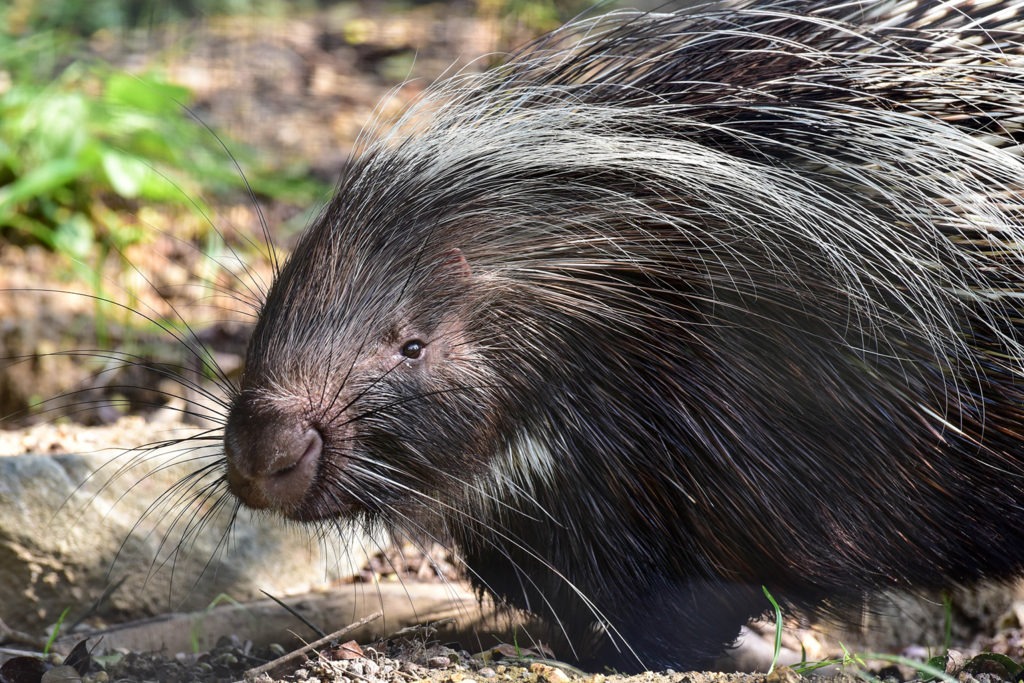Overview
“Where I live”
Cape porcupines, also called South African porcupines, are common throughout central and southern Africa. They are highly adaptable and can survive just about anywhere that vegetation is available. They are more likely to be found in open rather than wooded areas, though, and seek out rocky crevices and caves for shelter.
“How I live there”
Porcupines are large rodents. Cape porcupines are a terrestrial species of porcupine, otherwise known as “Old World” porcupines. These are distinguished from the arboreal porcupines of the “New World.” Terrestrial porcupines are found in the warmer regions of Africa, Asia, and Europe. They are the largest rodents in Africa and are surpassed in Asia and Europe only by beaver.
Cape porcupines are monogamous and live in small family groups comprised of an adult pair or an adult pair with offspring. They spend their days sheltering in rock crevices, caves, abandoned aardvark burrows, or underground burrows that they excavate themselves. A family group often develops an extensive inter-connected burrow system. They are less active when it is cold and will huddle together for warmth.
Cape porcupines come out at night and rustle around in search of food. They are shy and cautious when foraging, and while they appear clumsy in their movements, they can run fast enough to outpace humans when disturbed. Cape porcupines usually forage alone and sometimes in small groups. Like other rodents, they have a single pair of sharp, continually growing incisor teeth that they use to gnaw and rip tough plant material. They are also equipped with long claws that they use to dig up roots and tubers. They feed on these as well as fruit, bark, cultivated crops, and occasionally carrion. They are also known to collect bones to gnaw on in their dens.
“Making my mark”
The Cape porcupine is the largest porcupine in the world, alongside the nearly identical African crested porcupine. Both species have long, white, stiletto-like quills running the length of their backs that, when raised, make the animals appear at least twice as large as they actually are.
“What eats me”
Lions, hyenas, leopards, and birds of prey may attempt to attack porcupines but they won’t have much success. Porcupines are not easy to attack. When approached by a predator, Cape porcupines freeze first but then turn aggressive if cornered. They give their attackers plenty of warning signs. They bristle their quills, rattle their tails, stomp their feet, hiss, and snort. If the attacker persists, then the porcupine will whip around and charge backwards or sideways in order to lodge razor-sharp quills into the attacker. No porcupine can shoot its quills, but any porcupine can do significant damage by stabbing.
Raising Young
Female Cape porcupines give birth to one litter per year, producing anywhere from one to four offspring, but usually two. At birth, baby porcupines — known as porcupettes — are covered in soft, sensitive bristles. As they start to move around outside the den, the bristles harden into quills. Young Cape porcupines start to eat solid food at about one month of age but continue to nurse for 3 to 4 months. The young porcupines remain with their parents in small family groups for many months more until they are ready to find mates of their own.
Conservation
Cape porcupines are fairly common throughout their range, although overhunting may explain their absence in some areas. Farmers tend to view porcupines as pests because of their destructive feeding habits, especially where root crops, potatoes, ground nuts, and maize are grown. (The porcupines are diggers and also damage trees by stripping bark.)
Taxonomy
- Kingdom: Animalia
- Phylum: Chordata
- Subphylum: Vertebrata
- Class: Mammalia
- Order: Rodentia
- Family: Hystricidae
- Genera: Hystrix
- Species: africaeaustralis


